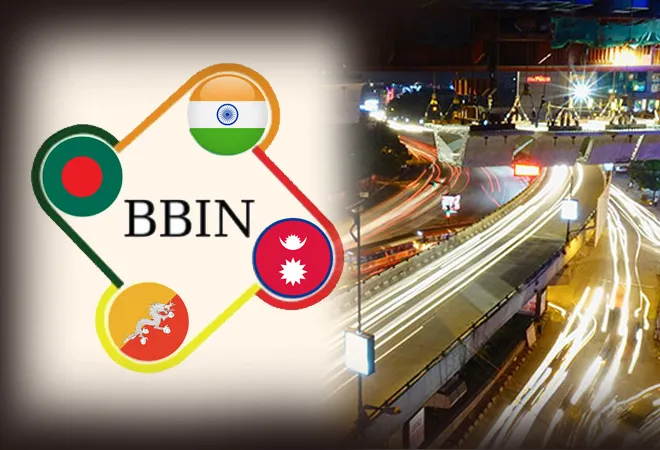At the September 2022 bilateral summit, the prime ministers of India and Bangladesh agreed to expedite efforts for expanding bilateral and sub-regional connectivity through early operationalisation of the Bangladesh, Bhutan, India and Nepal (BBIN) Motor Vehicles Agreement (MVA) inked in June 2015.
A number of issues, including lack of harmony in the motor vehicles laws of the member nations are hindering the implementation of the landmark agreement.
Dhaka is seeking New Delhi’s cooperation for conducting trade with Nepal, which intends to transport goods to Bangladesh through India’s territory, and has called for greater sub-regional connectivity under the BBIN MVA.
India has offered free transit via its territory to Bangladesh for exporting its products to third countries through specified Land Custom Stations (LCS)/airports/seaports.
In this regard, India has invited Bangladesh’s business community for using its port infrastructure for transshipment to third countries. India has been providing free transit to Bangladesh for exporting its products to Nepal and Bhutan.
India also requested Bangladesh to remove port restrictions. Reiterating the importance of facilitating trade, both the sides underscored the need for up gradation of infrastructure and facilities at the LCS/Land Ports for removal of port restrictions and other non-tariff barriers at identified LCS.
The Indian side reiterated its request for at least one major land port without restrictions or negative list of restrictions, on the border with North Eastern states, for easier market access, starting with Integrated Check Post (ICP) Agartala-Akhaura.
Progress has been made on India-assisted development of a second freight gate at Petrapole-Benapole ICP and both the sides agreed to complete the work at the earliest.
The border areas of India and Bangladesh, which remained backward for several years, are now reaping the benefits of increased trade, connectivity and people-to-people exchanges.
During the visit of Bangladesh Prime Hasina to India in October 2019, both the governments agreed to launch the Dhaka-Siliguri-Gangtok-Dhaka and Dhaka-Siliguri-Darjeeling-Dhaka bus services to enhance people-to-people contacts between the two countries.
Subsequently, the trial run of the Dhaka-Siliguri-Gangtok-Dhaka was held in December 2019.
As per recent reports, the state-run Bangladesh Road Transport Corporation (BRTC) has decided to launch three new bus routes between India and Bangladesh as people are interested in travelling by bus which is more affordable than other means of transportation.
The bus routes include Chittagong-Kolkata, Dhaka-Gangtok-Darjeeling and Cox’s Bazar-Chittagong-Agartala. The BRTC is reportedly mulling the idea of opening the Dhaka-Gangtok-Darjeeling bus service first as there are many passengers for this route.
The BRTC also intends to open the Barishal-Kolkata bus route after the completion of its survey work.
At the bilateral talks, Bangladesh has also reiterated its keenness to join the 2800 km-long India-Myanmar-Thailand Trilateral Highway.
Reports say the project has been facing some hurdles in Myanmar segment of the road for quite some time. India’s Minister of External Affairs Dr Subramanyam Jaishankar on August 8, 2023, acknowledged the challenges posed by Myanmar’s precarious internal security situation to various infrastructure development projects, including the trilateral highway initiative connecting Manipur’s border town Moreh with Mae Sot in Thailand.
This is a significant move towards enhancing regional connectivity. The segment of the highway that lies in Myanmar is still under construction.
India has been engaged with Myanmar to address the challenges in the border areas. Myanmar’s Sittwe Port is operational and India seeks to conclude a coastal shipping agreement with the South East Asian country soon.
The Government of India has undertaken the construction of the two sections of the trilateral highway in Myanmar—the 120.74 km Kalewa-Yagyo Road and 69 bridges along the approach road of the 149.70 km Tamu-Kygione-Kalewa Road.
Meanwhile, the Bangladesh Highway Authority has already taken steps to connect the Sylhet Highway with the ongoing India-Myanmar-Thailand Trilateral Highway Project under the Asian Development Bank and South Asia Sub-regional Economic Cooperation (SASEC) infrastructure development initiatives and Dhaka’s business community is hopeful that the country’s exports to Myanmar and Thailand would increase to a considerable extent.
Due to the delay in operationalisation of the BBIN MVA, Bangladesh is facing some transit issues while conducting trade with Nepal and Bhutan.
Reports suggest that the Bangladesh side raised the issue during the recent bilateral talks with India. Dhaka also appraised New Delhi about Nepal and Bhutan using Bangladesh’s ports for transportation of goods through Indian territory.
Bangladesh’s Commerce Minister Tipu Munshi said the issue of transit has remained unresolved mainly due to Bhutan’s transport infrastructure bottleneck even though India allowing free transit through its territory under a bilateral transit arrangement with the Himalayan kingdom.
India has agreed to allow free transit facilities through its specified corridors under the BBIN MVA, while Bhutan has sought some more time in this regard.
Reports say India has expressed its willingness to transport goods from Bhutan to facilitate the Bangladesh-Bhutan trade. The government of Nepal is also keen on enhancing sub-regional commercial ties.
Besides, New Delhi has offered transshipment facility to Bangladesh for using India’s ports situated in the western coast.
During the September 2022 bilateral connectivity discourse, India proposed one transit route from Bangladesh to Meghalaya’s Mahendraganj through West Bengal. Bangladesh’s goods are transported to India’s North East mainly through the narrow Siliguri Corridor, and in order to enhance the flow of goods, New Delhi is seeking an alternative land route.
Bangladesh’s connectivity with India’s North East and South East Asia would be expanded further once this transit route is developed.
The existing transport network in Bangladesh’s northern region is less developed compared to other parts of the country, and the AL government has to determine the economic viability of the proposed land route.
Reports indicate that this is a costly proposition as the road entails building of a 13 km-long bridge over the mighty Jamuna river.
But it is also expected that Bangladesh’s policy makers will acknowledge the economic dividends of developing such a mega transport infrastructure that will significantly contribute towards the country’s gross domestic product (GDP) and facilitate the integration of its rapidly growing market with the Association of South East Asian Nations (ASEAN).
After their visits to Assam and Meghalaya in 2022, some former diplomats of Bangladesh have said there is a growing realisation among state government officials and local people that a new narrative of sub-regional connectivity is emerging as the land-locked region has suffered due to closure of pre-partition era cross-border road, rail and waterway connectivity links after the 1965 India-Pakistan war.
Therefore, the question of economic reintegration of the sub-region has been given priority by the political leadership of the two countries.
In this context, Prime Minister Hasina stated that her government was not a party to the 1965 conflict and is keen to fully restore the previous links to usher in a new era of development and prosperity of the region.
There has been a phenomenal growth of people-to-people contacts between the two neighbouring nations after Hasina’s assumption of power in 2009. Reports say about 2.5 million Bangladeshis have visited India in recent years for various purposes.
People-to-people ties between India and Bangladesh take place mostly through cross-border road connectivity. About 70% of people of both the nations prefer to take the land routes across the international borders and rest 30% of the people travel by rail and air.
Such cross-border linkages that play a crucial role in the local economy were disrupted by Pakistan’s military junta of Ayub Khan after the 1965 war with India.
The current border haats between India and Bangladesh should be seen in the context of restoring natural linkages.
The expansion of cross-border connectivity will benefit people on both sides of the international border because India’s relations with immediate neighbours mostly rest on people-to-people ties.
The India-Bangladesh ties have broadened and deepened under Hasina and her AL government’s foreign policy priorities converge with India’s “Neighbourhood First” policy.
India’s former High Commissioner to Dhaka Pankaj Saran observes that this foreign policy is rooted firmly on the ground.















